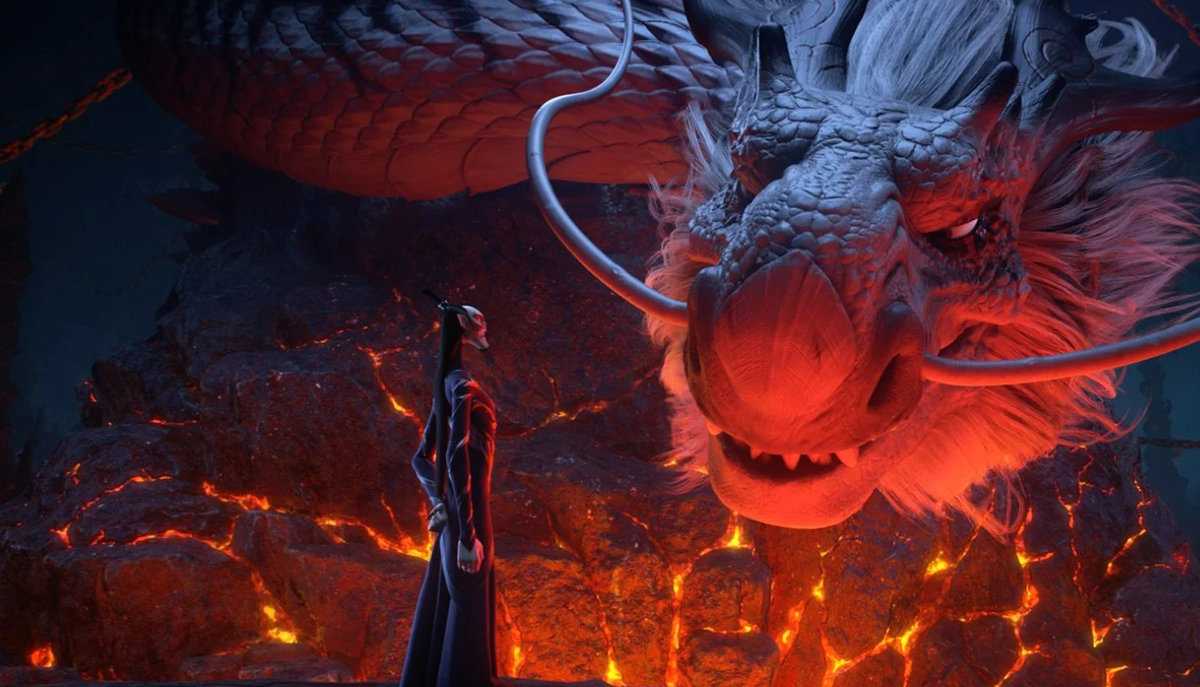In Ne Zha 2, the demon child is back, and this time, he’s already eaten Pixar for breakfast. Chinese director Jiao Zi returns to his animated juggernaut with a sequel so overstuffed and committed to outdoing itself that it might as well have come with a motion sickness warning. That it also contains some of the most emotionally sincere storytelling this side of a Ghibli tearjerker makes it one of the year’s strangest and most strangely moving cinematic experiences.
Ne Zha 2 is now the fifth highest-grossing film of all time, and the biggest animated film ever globally, having knocked Inside Out 2 off its comfortable pedestal with the casual ease of a child-god smashing a mountain (which, incidentally, happens here). That kind of box office flex would be enough to earn Jiao Zi a seat at Mount Cameron, right next to the king of the world himself. But Jiao Zi clearly isn’t just here to cash cheques. He’s made something that feels mythic in every sense — a staggering cinematic achievement that swings for the heavens with the ferocity of a fire-wielding demi-god and the precision of a legendary storyteller.
Ne Zha 2 (Mandarin)
Director: Jiaozi
Cast: Lü Yanting, Han Mo, Lu Qi, Zhang Jiaming, Wang Deshun, Zhuo Yongxi
Runtime: 144 minutes
Storyline: After the catastrophe, although the souls of Ne Zha and Ao Bing were saved, their bodies would soon be shattered. Taiyi Zhenren planned to use the seven-colored lotus to rebuild their bodies
For those uninitiated into the lore, the film does try to catch you up. The sacred Chaos Pearl split in two, the resurrection of two mythical boys from lotus paste, the city of Chentang Pass under siege, and an intergenerational celestial beef between dragons, demons and gods — all this is delivered in an early burst of exposition that feels like someone set Xu Zhonglin’s Investiture of the Gods on fire and tried to tell you the plot before the smoke cleared. But even if the mythology occasionally overwhelms, the core is still crystal clear: a fierce, messy, stubborn devotion between Ne Zha, the demon child, and Ao Bing, his noble dragon counterpart.

A still from ‘Ne Zha 2’
| Photo Credit:
Beijing Enlight Pictures
The crux of the story is simple enough: Ao Bing’s soul is fading, and Ne Zha will tear heaven itself apart to save him, despite Ao Bing now occupying Ne Zha’s body like a spectral roommate. What makes Ne Zha 2 so compelling, and frankly, so weird, is its high art/lowbrow tonal whiplash. The film careens between sequences of stunning, almost spiritual beauty and scenes where characters slurp down urine-infused tea with a surprising degree of finesse.
But there’s something exhilarating about the scale of the thing. Chengdu Coco Cartoon reportedly employed over 4,000 workers to produce the film, and their labour is etched into every shimmering water droplet rendered like liquid glass, and every theatre-shaking explosion of molten gold. When dragons burst from rips in the sky or armies clash mid-air, even an IMAX screen starts to feel like it’s about to burst at the seams. The grand final act of a polychromatic war waged on a gargantuan floating cauldron is animated cinema at its most maximalist.

And yet, Ne Zha 2 is also grounded by a surprising tenderness. Jiao Zi is smart enough to know that myth without heart is just noise, and so he threads little tearjerkers into the bombast, like a mother suffering a hundred needles to hug her son goodbye, and the world’s greatest dragon dad breaking the cycle of burden for his son. Even the villains, like the disgraced immortal Shen Gongbao, are granted moments of grief and regret. These flashes of humanity amid the divine fireworks make the film resonate more deeply than it has any right to.
But most importantly, Ne Zha 2’s critique of Western imperialism feels incandescent. Beyond its on-the-nose symbolic imagery of its eagle-crested jade medallions and dollar-sign death furnaces, the film systematically dismantles the moral scaffolding of hegemonic power under the guise of celestial authority. Cloaked in the rhetoric of “civilisation” and “enlightenment,” the celestial Chan sect stands in for imperial powers that repackage subjugation as salvation. Their exploitation of dragons and demons under the banner of reform echoes a long history of colonial manipulation, offering elevation in exchange for obedience, and punishing resistance with obliteration.

A still from ‘Ne Zha 2’
| Photo Credit:
Beijing Enlight Pictures
But what really elevates it beyond simple allegory is how it reclaims the demonic, vilified ‘Other’, as revolutionary, rather than as victim. Ne Zha’s ultimate decision to embrace his identity rather than “pass” into acceptability is a pointed rejection of assimilation into oppressive systems. Unlike the current wave of contrite, state-sponsored Western superheroes, or the glut of sad boys in capes stuck in a cycle of moral ambiguity, Ne Zha is simply furious, and his clarity is radical: oppression is evil, resistance is righteous. In this light, Ne Zha 2’s blazing manifesto burns through its fantastical epic.
Is it perfect? Not remotely. The pacing often stutters under the weight of its sprawling lore, and some subplots feel like filler. While the animation is frequently jaw-dropping, the frenetic editing can also leave you gasping for air. But then Ne Zha grabs a bamboo pole, leaps into the rain, and does battle midair with a sentient lightning bolt, and all is forgiven.

The gloriously unhinged fever dream of Ne Zha 2 is where the sacred meets the slapstick, and somehow, it just works. But above all, it makes the case that animation, in the right hands, can do absolutely anything. Including knocking a few billion-dollar Hollywood franchises off their high horses, with time left over to kneecap a Marvel release at the box office.
Ne Zha 2 is currently running in theatres
Published – April 25, 2025 04:59 pm IST



